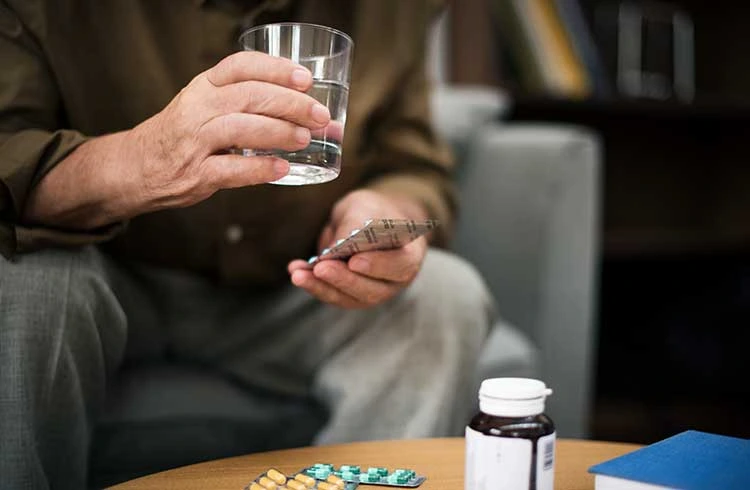Zydol (Tramadol) – A “Favourite” Among Athletes and Others
Recently, there has been growing public attention—particularly in the world of sport—on a medication commonly used for pain relief: zydol, whose active ingredient is tramadol. For this reason, the term tramadol is often used as a synonym for Zydol. But why has Zydol come under the spotlight, and why is it, quite rightly, considered a drug of concern?
Due to the widespread misuse of this medication, the use of zydol (tramadol) has been officially banned in all sports competitions as of 1 January 2024. This decision was announced by the World Anti-Doping Agency (WADA). Any professional athlete found using tramadol after this date risks receiving a lifetime ban from competitive sport. Tramadol use had been particularly common among cyclists, which is why zydol tablets are now strictly prohibited within the sport of cycling.
Therefore, Zydol (tramadol), which in the UK is commonly known as tramadol, is frequently used by athletes. They often turn to this medication to achieve impressive (sometimes unrealistic) results during moments of intense pain.
Unfortunately, the widespread use of Zydol (tramadol) is not confined to professional athletes. An increasing number of “ordinary” people, not just in the UK, but around the world, are abusing this medication. The main reason for Zydol use disorders lies in the opioid properties of the drug. As a result, Zydol is effective at relieving or completely eliminating moderate to severe pain.
What is Zydol and what is it used for? What effects do Zydol tablets cause? Why is Zydol considered a drug? To what extent does the drug tramadol (Zydol) cause addiction? How do Zydol tablets, as opioid analgesics, affect the body and brain? Find the answers to these and many other questions related to Zydol on our blog.
What is Zydol and what is it used for?
In the introductory section, we noted that Zydol (tramadol) is frequently abused due to its analgesic properties. However, it’s important to explore the true nature of this medication in more depth. So, the question arises: What is Zydol, and what is it intended for?
In the broadest sense, Zydol is a painkiller. Like all other opioid analgesics, it is used to treat and alleviate moderate to severe pain. The active ingredient in Zydol is tramadol (full name – tramadol hydrochloride). This is why the terms “Zydol” and “tramadol” are essentially synonymous, and we will use them interchangeably throughout this text.
Therefore, Zydol is a narcotic opioid analgesic whose action targets the central nervous system (CNS). When a person takes Zydol tablets, the drug binds to opioid receptors in the brain and spinal cord. Once bound to these receptors, Zydol, like all other opioid analgesics, effectively relieves pain.
So, if you’re wondering “What is Zydol and what is it used for?“, it’s important to know that Zydol tablets are prolonged-release, meaning the medication is released slowly over time. Zydol is prescribed solely for the treatment of moderate to moderately severe pain. It is commonly given to patients following surgery, or for the management of chronic pain conditions such as fibromyalgia, neuralgia, or myocardial infarction (heart attack).
Tramadol has a high potential for addiction, and dependence can develop after just a few uses. The problem is made worse by the fact that Zydol is relatively easy to obtain from pharmacies. Although it is officially available only with a prescription, tramadol can also be found online.
Some of the other names for Zydol (in addition to tramadol) include:
- Maxitram,
- Marol,
- Zamadol,
- Tramulief,
- Tramquel

How is Zydol used?
Zydol is taken orally, in the form of tablets. As mentioned earlier, it is only available with a doctor’s prescription. This means that tramadol should be used strictly in therapeutically prescribed doses and only for the duration recommended by a medical professional.
As a rule, Zydol should be taken exactly as prescribed—at the time, in the manner, and in the dosage specified by a doctor. Unfortunately, misuse of this medication is widespread, with many individuals turning to tramadol for self-medication. In such cases, people often determine their own doses—usually higher than recommended—and take it more frequently than medically advised.
When prescribed by a doctor, the dose of Zydol is determined based on the degree and intensity of the pain the patient is experiencing. Additionally, the prescribing doctor will consider the individual’s pain sensitivity—also known as their pain threshold—when adjusting the appropriate dosage.
As a rule, due to the risk of misuse and its addictive potential, Zydol is prescribed in the lowest effective dose needed to relieve pain. Zydol tablets are typically available in doses of 50 mg, 100 mg, 150 mg, 200 mg, and 300 mg. The maximum recommended daily dose should not exceed 400 mg, unless specifically prescribed by a doctor.
Opioid Analgesics – Why Are Zydol Tablets Considered Dangerous?
When used correctly, Zydol tablets can be effective in relieving moderate to moderately severe pain. It’s also worth noting that, among opioid analgesics, tramadol is considered one of the less potent painkillers. In other words, its effects are milder compared to stronger opioid analgesics such as methadone or hydrocodone. In general, Zydol is viewed as a safer alternative to these more powerful narcotic painkillers—but it still carries significant risks, especially when misused.
However, this does not make tramadol tablets—any less dangerous. On the contrary, when Zydol is taken over a long period, compulsively or without medical supervision, the risk of developing an addiction and experiencing other harmful health effects increases significantly. The same applies when Zydol is taken in higher doses than those prescribed by a doctor.
Although Zydol is often considered a safer alternative to opioids like morphine and hydrocodone, its misuse is becoming increasingly common—particularly among young people. Since tramadol is taken orally, Zydol tablets must first be metabolised in the liver, where they are broken down into several active compounds. One of these is desmetramadol (O-desmethyltramadol or O-DSMT), which has a much more potent effect than tramadol hydrochloride itself.
When tramadol is taken in large doses and over a prolonged period, it can induce a “high” or euphoric feeling, similar to the effects produced by oxycodone (OxyContin). Like all other opioid analgesics, Zydol can have side effects even when used as prescribed by a doctor. We will discuss the side effects of Zydol both during regular use and when abused.
Zydol and Its Abuse Among Adolescents
Children under the age of 12 should never take Zydol. It is a concerning fact that the misuse of tramadol is becoming increasingly prevalent among high school students and teenagers. As a result, adolescents all over the world—including in the UK—frequently use tramadol for non-medical reasons, without proper supervision or prescription.
Some reports indicate that nearly one in ten high school seniors have misused narcotic analgesics (excluding heroin), including Zydol tablets, without any medical need. As mentioned earlier, this issue is further compounded by the fact that Zydol is available online as well as on the street.
For this reason, it is not surprising that a significant number of teenagers have become addicted to tramadol. Parents should remain vigilant about what their children are searching for on the Internet and be quick to respond to any early physical, psychological, or behavioural changes in their children.
Combining Tramadol with Other Drugs – A Recipe for Abuse and Addiction
First and foremost, Zydol should never be taken in combination with other opioid analgesics. It is not uncommon for tramadol to be misused alongside other substances (known as polydrug use or polytoxicomania) in an attempt to enhance or intensify its effects. The result of combining Zydol with other drugs is almost always dependence on tramadol.
Experience has shown that many heroin addicts, when unable to obtain their usual drug, often seek a substitute in alcohol and other psychoactive substances, such as strong opioid analgesics, psychiatric medications, and Zydol. This leads to polydrug use. Consequently, drug users may begin taking large doses of Zydol, alcohol, and other substances—often all at once. This combination can result in an overdose, potentially leading to a fatal outcome.
Although it can cause serious health complications, tramadol is most commonly combined with the following substances:
- Alcohol
- Other painkillers (analgesics)
- Marijuana
- Buprenorphine
- Tranquilisers, such as Bromazepam, Lorazepam, and sleeping pills
- Cold and flu medicines
The risk of developing an addiction to tramadol increases significantly when zydon is taken in combination with other substances. As a central nervous system (CNS) depressant, zydon can be extremely dangerous when mixed with other CNS depressants such as alcohol, opioids, or sedative-hypnotics. Combining zydon with these substances can lead to respiratory depression and, in severe cases, respiratory arrest (hypoventilation).
Additionally, taking tramadol alongside the aforementioned substances increases the risk of seizures, overdose, and sudden death.
Why is Zydol considered a drug?
The vast majority of people are unaware that zydol is classified as a drug. This is largely because, when taken in higher doses, more frequently, or for a longer duration than prescribed, zydol can lead to addiction and associated complications.
Like other opioid analgesics, zydol alters the body’s response to pain by interacting with opioid receptors. Zydol activates these receptors, which in turn increases the activity of dopamine – the pleasure hormone. This is precisely why zydol can be misused and abused, even when there is no legitimate need for it. Abuse of zydol inevitably leads to addiction, which is why it is rightly referred to as a drug.
Zydol was not initially classified as a controlled substance when it was approved by the Food and Drug Administration (FDA) in 1995. However, in 2014, following numerous reports of widespread misuse, tramadol was reclassified as a Schedule IV controlled substance. This change reflects the fact that zydol tablets do carry a potential for abuse and addiction.
Therefore, it can be said that when zydol is misused or taken for non-medical purposes, it effectively becomes a drug of abuse.
Why is Zydol considered a drug – even a “truth drug”?
Believe it or not, Zydol is sometimes referred to as a “truth drug.” This is because, under its influence, a person may become highly empathetic and emotionally sensitive, which can make it particularly appealing to introverted individuals. Zydol can have such a strong emotional impact that it may lead to episodes of (apparent) honesty.
Under the influence of Zydol, a person may express repressed emotions towards family members, friends, or colleagues. In some cases, this emotional release can be so intense that the individual feels compelled to verbalise their feelings, even in situations where it may be socially inappropriate or uncomfortable.
In the UK and beyond, Zydol is often combined with marijuana. Specifically, individuals may take marijuana alongside Zydol to enhance its effects. Interestingly, even a small dose of marijuana (cannabis) can significantly amplify the effects of Zydol. As a result, even a small amount of marijuana can make the effects of Zydol much stronger than its typical analgesic action.
The combination of marijuana and Zydol can be very dangerous. The simultaneous abuse of these two substances increases the risk of epileptic seizures.
How do opioid analgesics and Zydol work?
Zydol is classified as an opioid narcotic. Like other opioid analgesics, tramadol belongs to the same category as drugs like morphine, codeine, and hydrocodone.
Opioid analgesics, including Zydol, work by interacting with opioid receptors in the brain and spinal cord. This not only alleviates pain but also induces an increase in feelings of pleasure. As such, tramadol can produce a euphoric “high,” especially when misused. Narcotic opioid analgesics, including tramadol, are commonly abused due to these effects, particularly when used recreationally.
As Zydol is a central nervous system depressant, it slows down the body’s vital functions. This results in a decrease in heart rate, blood pressure, body temperature, and breathing rate. One of the effects of taking Zydol is stress relief and bodily relaxation.
Tramadol: Increases Pleasure and Exhibits Antidepressant Effects
Zydol not only targets opioid receptors but also boosts dopamine levels in the brain, similar to other opioids. Additionally, tramadol inhibits the reabsorption of norepinephrine (noradrenaline) and serotonin, which is akin to how many selective serotonin-norepinephrine reuptake inhibitors (SNRIs) work in the brain. This combined action, providing both pain relief and mood-enhancing effects, distinguishes tramadol from traditional opioid analgesics.
Due to its ability to improve mood, individuals may be tempted to take higher doses or use tramadol more frequently than prescribed, leading to the potential for abuse and addiction.
The effects of tramadol can be intensified when its form and method of administration are altered. For instance, when Zydol tablets are crushed and then snorted, injected, or smoked, the entire dose enters the bloodstream at once rather than being gradually released, as intended with its extended-release formulation.
This significantly increases the risk of overdose and can lead to side effects such as nausea, stomach cramps, dizziness, and drowsiness. In general, when tramadol is misused or taken for non-medical purposes, it can produce a euphoric “high” that induces a sense of relaxation. This may result in elevated mood, reduced pain and anxiety—but can also trigger seizures and convulsions.
Zydol and its Side Effects
The side effects of Zydol (tramadol) can generally be divided into two categories:
- Adverse effects associated with regular use
- Adverse effects associated with misuse or abuse
1. Tramadol (zydol) and Side Effects During Regular Use
Like all medications, Zydol (tramadol) can cause certain unwanted effects, even when taken exactly as prescribed by a doctor. Some of the common side effects may include:
- Nausea
- Vertigo (dizziness)
- Fatigue
- Headache
- Drowsiness
- Vomiting
- Dry mouth
- Loss of appetite
- Constipation
- Excessive sweating
- Rapid heart rate and palpitations
- Drop in blood pressure when standing (orthostatic hypotension)
- Skin allergic reactions, such as itching, rashes, and hives
In extremely rare cases, the following side effects may occur:
- High blood pressure (hypertension)
- Breathing difficulties and circulatory issues
- Tingling sensation in the skin
- Tremors
- Muscle cramps
- Involuntary muscle contractions and uncoordinated movements
- Confusion, disorientation, sleep disturbances, and nightmares
- Blurred vision
- Hallucinations
- Difficulty or pain while urinating
When people use Zydol (tramadol) recreationally or for non-medical purposes, the appearance of the listed side effects can often serve as a warning sign of misuse or abuse.
2) Zydol and side effects resulting from misuse
As one of the less potent opioid analgesics, Zydol is often mistakenly perceived as having little or no addictive potential. This false sense of safety can lead individuals to develop a dependency on tramadol without even realising it.
Taking Zydol without a doctor’s prescription, using higher doses, taking it more frequently, or continuing use for longer than advised—all constitute misuse of the drug. Combining tramadol with other substances to intensify its effects is also considered abuse.
In the early stages of Zydol (tramadol) misuse, a person may initially experience certain pleasant sensations. As previously mentioned, these include an elevated mood, a euphoric “high,” reduced anxiety and emotional distress, and relief from physical pain. We have also outlined the mechanism by which Zydol produces these effects.
The issue is that all the mentioned pleasant effects are short-lived – and in some cases, may not appear at all. When someone continues to misuse Zydol in an attempt to recreate those sensations, serious side effects and adverse reactions often follow. In other words, any initial pleasurable feelings quickly turn into a compulsive need for increasingly higher doses, leading to significant health risks.
It is crucial to recognise the signs of Zydol misuse as early as possible in order to prevent further health complications.
Adverse effects of Zydol abuse include, but are not limited to:
- Constricted (very small) pupils
- Changes in appetite (either increased or decreased)
- Nausea
- Vomiting
- Headaches
- Drowsiness
- Slurred speech
- Impaired coordination
- Breathing difficulties
- Tremors
- Depression
- Muscle pain
- Constipation
- Dizziness (vertigo)
- Excessive sweating
- Raised body temperature
- Dependency/addiction
Abuse of tramadol can lead to serious side effects, including seizures.
These typically occur when high doses (usually 400 mg or more per day) are taken over an extended period. The risk of seizures is significantly higher when Zydol is combined with antidepressants.
More severe symptoms of Zydol abuse typically occur when higher doses of the drug are taken, or when Zydol is combined with other substances.
These serious symptoms may include the previously mentioned seizures, but also central nervous system (CNS) depression. CNS depression is a condition where the central nervous system slows down to such an extent that heart rate and breathing are significantly reduced. This can lead to unconsciousness, coma, and even death.
Another potentially dangerous side effect of Zydol abuse is serotonin syndrome, which can be life-threatening if not treated promptly. This syndrome occurs when there is an excessive amount of serotonin, a neurotransmitter that transmits signals in the brain. Serotonin syndrome most often arises in individuals who take Zydol alongside antidepressants.
Symptoms of serotonin syndrome include:
- Confusion;
- Agitation;
- Twitching muscles;
- Rigid muscles;
- Tremor;
- Lack of coordination;
- Attacks;
- Coma.

Zydol – What is Zydol addiction?
As we’ve seen from the previous text, Zydol is undoubtedly a drug that can lead to addiction. As an opioid analgesic, it belongs to the same category of substances as oxycodone and morphine, though its effects are milder. This mild effect can lead individuals using Zydol to believe it doesn’t carry a risk of addiction, which is a significant misconception.
Addiction to Zydol can develop, particularly if the drug is used over an extended period.
Zydol not only blocks the sensation of pain by binding to opioid receptors, but it also increases levels of serotonin and noradrenaline. As a result, the individual’s mood improves, but this effect is short-lived. Once the effect wears off, the person may feel compelled to use Zydol again, even if the pain is no longer present.
Repeated consumption of Zydol over a prolonged period can lead to the development of a habitual reliance on the drug. This habit gradually, and often imperceptibly, evolves into compulsive behaviour and addiction to Zydol.
Addiction to Zydol is a consequence of its dual effect. The first effect is pain relief, while the second is the euphoric “high”, which induces relaxation and stress relief. At the same time, Zydol has both analgesic and antidepressant properties. The combination of these effects makes tramadol a highly addictive substance.
Over time, the body becomes accustomed to the presence of Zydol, leading to tolerance. This means that a person will require higher doses or more frequent use to achieve the desired dual effects. In the event of sudden discontinuation, a withdrawal crisis will occur.
Thus, Zydol addiction is a chronic, neurobiological condition of the brain, influenced by genetic, psychosocial, and environmental factors.
Tramadol – Signs and Symptoms of Zydol Addiction
If an individual displays two or more of the following patterns of problematic tramadol use within a 12-month period, it is considered a clear indication of a Zydol use disorder.
The following are the key signs and symptoms of Zydol addiction:
- Using higher doses of Zydol than prescribed by a doctor
- Continuing to take Zydol despite being aware that it may worsen a physical or emotional issue
- Spending a significant amount of time seeking, obtaining, using, or recovering from the effects of Zydol
- Frequent conflicts with close family or friends due to tramadol use
- Neglecting responsibilities at home, school, or work as a result of Zydol misuse
- Giving up hobbies or activities that were previously enjoyable, in favour of using Zydol
- Using Zydol in situations that carry social or physical risk (e.g. while driving)
- Repeated unsuccessful attempts to reduce the dose or stop using Zydol altogether
- Strong cravings or urges to take Zydol (psychological dependence)
- Developing a tolerance to tramadol, leading to more frequent or higher doses to achieve the desired effect (physical dependence)
- Experiencing withdrawal symptoms when Zydol use is suddenly reduced or stop
Zydol (Tramadol) and Withdrawal Symptoms
When someone becomes dependent on Zydol (tramadol), suddenly stopping or reducing the dose can trigger uncomfortable and often distressing withdrawal symptoms. These symptoms may appear even in individuals who have been using tramadol as prescribed.
Withdrawal occurs because the body has become chemically dependent on the drug through regular use. Over time, a person develops a tolerance to Zydol – meaning the body becomes less responsive to its effects. As a result, higher doses or more frequent use may be needed to achieve the same results, such as pain relief, improved mood, or a euphoric sensation.
Zydol withdrawal symptoms typically last between five and seven days.
When a person becomes “hooked” on the drug Zydol, the brain attempts to regulate various functions by either speeding up or slowing down certain processes. In the event of a sudden cessation of Zydol use, the brain enters a state of shock and “overload”. In an effort to restore homeostasis, which has been disrupted by the abrupt discontinuation of the drug, the body responds with mild, moderate, or severe withdrawal symptoms.
When it comes to withdrawal from Zydol, many individuals describe the symptoms as flu-like. Additionally, the withdrawal crisis is often marked by panic attacks, anxiety, and hallucinations.
Zydol Experiences
Below is a personal account from someone who has struggled with Zydol abuse and addiction:
“My wife left me and took our children because of Zydol. My entire life started to revolve around it. I originally began taking Zydol to manage severe back pain, but over time I became addicted to the drug. Every time I tried to stop, I experienced unbearable pain throughout my body, along with anxiety and panic attacks. I simply couldn’t cope without taking it again. Please, be careful with Zydol. It helped with my pain, but it ruined my life.”
“No matter what anyone tells you, Zydol is a serious drug. I went through absolute hell during the years I was addicted to it. I remember once forgetting to take my dose before bed. That night, I had the worst nightmares, I was sweating like never before. The stomach cramps were so intense, I thought my insides were going to burst. That’s when I realised Zydol had turned me into an addict.”
“I was addicted to Zydol for seven years. And it all started so innocently—I had no idea Zydol could cause such a strong dependency. I couldn’t go a single day without it, and soon I began experiencing serious health issues. I was desperate to break free from this nightmare, and thankfully, I had the support of my family. We found the MedTim clinic, and in just seven days, they managed to pull me out of the hell I’d been living in for seven years.”
Zydol and how to stop using it for good
We’ve explained how Zydol works, how it can impact the body, and how its misuse can severely affect a person’s life. Zydol is indeed a drug, and it can lead to serious addiction—an addiction that is extremely difficult, and often impossible, to overcome alone. Many personal stories from former users have shown just how hard it is to break free without professional help.
The only safe and effective way to permanently stop the use of zydol is through medical detoxification and professional treatment!
MedTim addiction treatment clinic is a modern rehabilitation centre that specialises in the detoxification and recovery from all types of drug abuse, including zydol. With thousands of patients from around the world successfully treated at our facility, we have helped individuals overcome narcotic addiction, including dependence on Zydon.
We have achieved this success primarily thanks to our team of highly skilled experts with decades of experience in addiction treatment. We always prioritise the patient, their needs, and their family. Using the latest medical equipment, innovative treatment methods, and a personalised approach, we ensure that every patient receives the highest level of medical care and support.
Furthermore, we are always available to offer consultations, support, advice, and assistance to the patient’s family. At MedTim, together, we become a winning team!

Overcome Zydon Addiction in Just 14 Days – Safely and Effectively at MedTim Clinic
At the MedTim Clinic, Zydol addiction becomes a thing of the past, and in just 14 days of medical treatment, you can become a new person. All this is achieved without the use of substitution therapy at the end of the programme! Our “secret” lies in a completely safe and painless detoxification process, during which the patient’s body is thoroughly cleansed of Zydin and all associated toxic substances.
During detoxification at the MedTim clinic, patients do not experience any unpleasant or uncomfortable withdrawal symptoms from this medication. Once the detox process is complete, the body begins to recover naturally — sleep quality and mood improve, and the immune system becomes stronger.
In addition to standard medical detox, we also offer rapid detoxification – the UROD procedure. This is one of the most reliable and effective methods for cleansing the body of opiates and opioid analgesics, such as Zydol (tramadol).
Following detoxification and pharmacological treatment, the patient is fully prepared to begin the next phase – psychotherapy and the treatment of psychological dependence on Zydol (tramadol). Our team of psychiatrists and psychologists use clinically proven methods to address the root cause of the addiction.
We continue to support our patients even after they leave the clinic. For a full year after discharge, we stay in contact to monitor their progress, ensure long-term success, and, if necessary, adjust the treatment plan.
You are welcome to contact us at any time – the doors of MedTim are always open. Together, we overcome Zydol addiction.


